The Microsoft Surface Pro (2017) Review: Evolution
by Brett Howse on June 15, 2017 9:00 AM ESTDisplay Analysis
Microsoft has been the PC maker that has focused on display quality more than any other. And in only a few generations, they have become known for having the best displays of any company. It could be argued (and I would argue it strongly) that the Surface Studio has the best display of any consumer device for sale right now, even if Windows doesn’t yet offer full color management to take complete advantage of the DCI-P3 and P3 D65 display settings on the Studio.
The Surface Pro keeps the same display panel as the Surface Pro 4, with a 12.3-inch 2736 x 1824 display. That works out to 267 pixels per inch, in a 3:2 aspect ratio. The saying goes, if it isn’t broken, don’t fix it, and that’s the case here. Surface Pro 4 was easily the best display in its category, and offering more pixels per inch would be a game of diminishing returns for increased power requirements, leading to lower battery life, so the decision to stick with this panel was a great one.
However, not everything is identical. After building a system to change the color gamut for Surface Studio with a simple toggle in the Action Center, Microsoft took the same idea and put it to use on the Surface Pro. Since the Surface Pro is still only a sRGB display, it’s not quite the same as the Surface Studio being able to change from sRGB to DCI-P3 to P3 D65, but it does offer an Enhanced sRGB mode. What does that do exactly?
“The Enhanced setting on the New Surface Pro is a profile within the sRGB space where through special hardware and proprietary color processing we take the mid-tones as close to P3-D65 color gamut as possible while leaving skin tones as is. The overall color contrast is also enhanced.”
That’s the answer from Microsoft. It changes the tone map on colors to make them a bit more vivid, while still staying within the sRGB gamut, and without blowing out skin tones, making people look odd colors. In practice, it seems to work pretty well, offering a bit more pop, but without going overboard. It sounds like something that needs some data to sort it out though, so we’ll take a look at the Enhanced mode as well as sRGB mode.
One other note about the display that came up during testing is that it appears to have content adaptive backlight control (CABC) enabled by default. The effects were not nearly as dramatic as some of the other devices we’ve seen with it, but it would still shift the brightness by 20-30 nits. We’ll dig into that and see if we can get an answer, but with the limited time we’ve had the device, it’s only really stood out when trying to run the display testing.
To perform our display testing, we leverage SpectraCal’s CalMAN software suite. Measurements for contrast and brightness are done with an X-Rite i1 DisplayPro colorimeter, and color accuracy measurements are done with an X-Rite i1 Pro2 spectrophotometer.
Brightness and Contrast
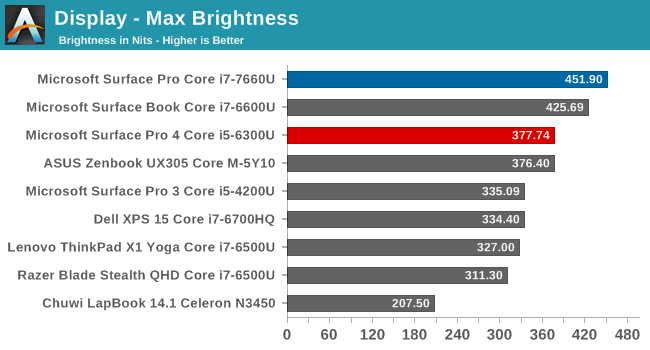
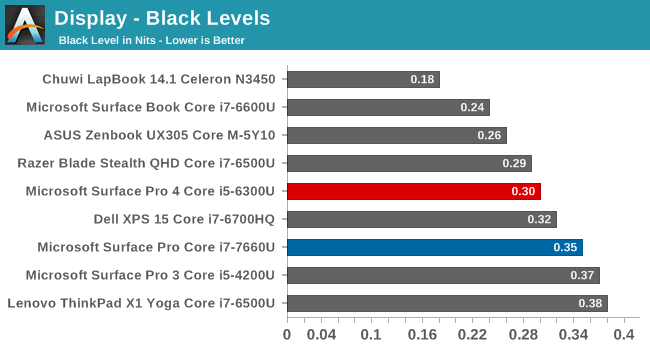
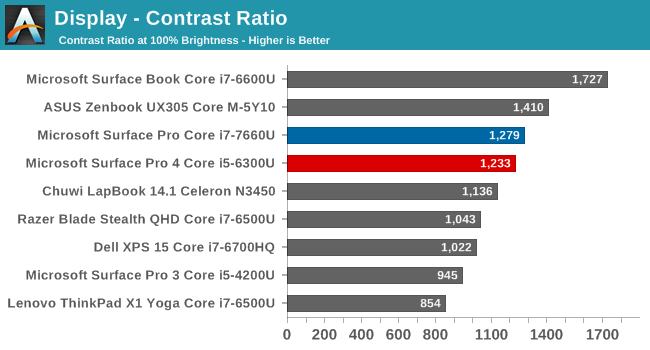
Any time you need to use a laptop or tablet outside, having a very bright display can be a very nice boost to usability. Here we see the Surface Pro has an outstanding 451 nits of brightness, making it one of the brightest PCs we’ve seen. Despite the high brightness, the black levels are still quite good, leading to a contrast ratio of 1279:1. It’s not quite Surface Book levels, but it’s still a great result. For those that want to use the device in a dark room, the display goes all the way down to 4 nits as well.
Grayscale
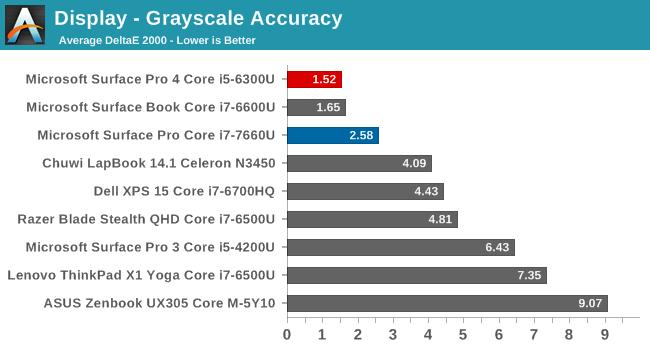
In sRGB mode, the grayscale results are good, but not perfect. The red levels drop off as the brightness increases, leading to a slightly cool display. The gamma levels are very close to the 2.2 level though, with some issues near 0% and 100% only. The model we received for review is a pre-production unit, so it’s possible the grayscale will be more accurate on shipping versions, or it could be because of the adjustable gamut. The average is still fairly good, but it's measurably worse than the Surface Pro 4 we've tested, and does cross the 3.0 level closer to 100% brightness.
Gamut
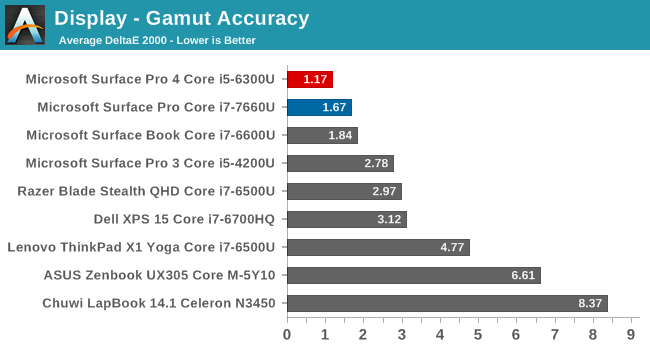
We’ve switched to 4-bit levels for the saturation sweeps, which is more accurate, but makes it difficult to see the gamut coverage clearly, so this test just shows the 100% levels to portray how much of a gamut the display can cover. You can see that the Surface Pro almost perfectly covers the sRGB color space.
Saturation
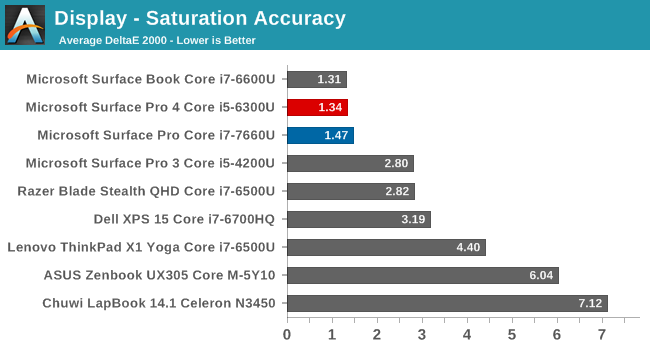
Although not quite hitting the amazing average of the Surface Pro 4 and Surface Book, even with the more demanding 4-bit steps on the saturation sweep, the Surface Pro is one of the best devices we’ve tested.
Gretag MacBeth
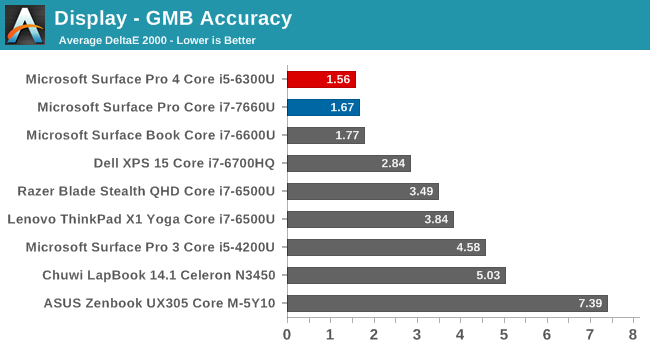
The colorchecker is the most comprehensive test, testing many more colors outside of the primaries and secondaries, and including the skin tones. Once again, the Surface Pro is one of the best devices we’ve tested.
Enhanced Mode
As stated above, the Surface Pro now includes an enhanced sRGB mode. It remaps the color tones slightly, but keeps it within the sRGB color space. It’s not going to be as accurate as the sRGB mode, which we just saw is very accurate to the sRGB gamut, but the enhanced mode is likely to provide many people with the more pleasing look that gives a bit more pop to the colors.
We’ve run the enhanced mode through the display testing as well to see what kind of effect it has on the display.
First off, you can see that the gamma is much lower than it should be. That’s not a surprise with the explanation Microsoft provided earlier on what the enhanced mode is, since they wanted to increase the contrast between the colors.
Looking at the saturation sweep, you can see the colors pulled slightly off the axis, with green having a large swing close to 100% green. All of the colors are tweaked somewhat though, especially as they get brighter.
Finally, looking at the Gretag MacBeth test, you can see that, in fact, the skin tones are not affected by this tone mapping, but the blues, reds, and greens are adjusted quite a bit.
Microsoft’s explanation for the Enhanced sRGB mode is exactly true. There is more contrast between colors, and the colors are tone-mapped but skin tones are not changed. It’s nice to see a toggle to still allow sRGB mode if people need to do color critical work, but as we've seen before in other products, many people are likely going to prefer the increased pop from the colors on Enhanced Mode, even though they're not as accurate. Even with this deviation from the sRGB specification, this would still be considered one of the more accurate displays available, considering the Gretag Macbeth dE2000 is still less than three.


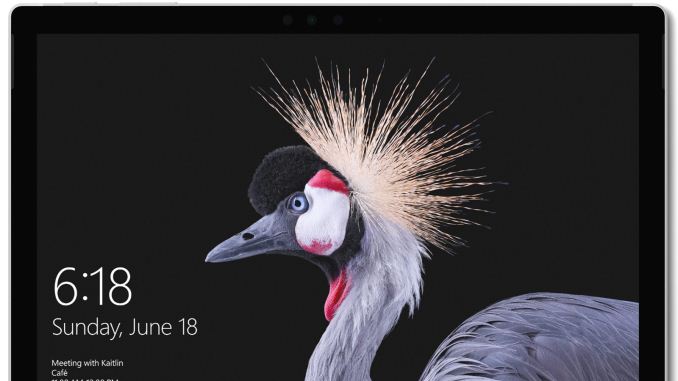
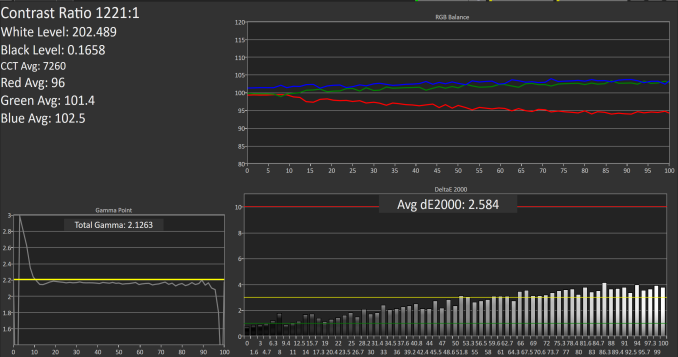

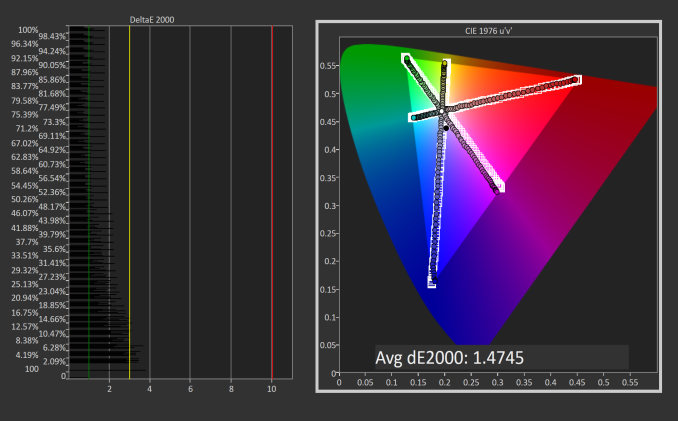

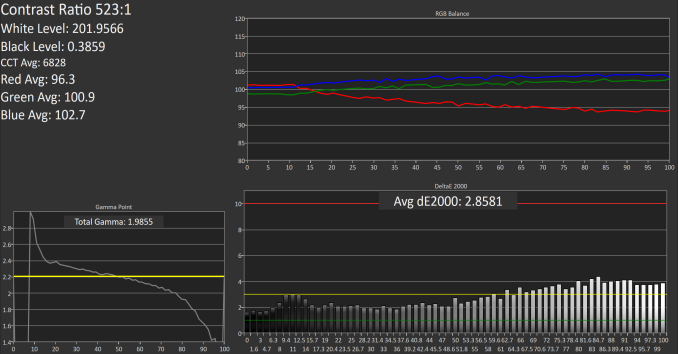
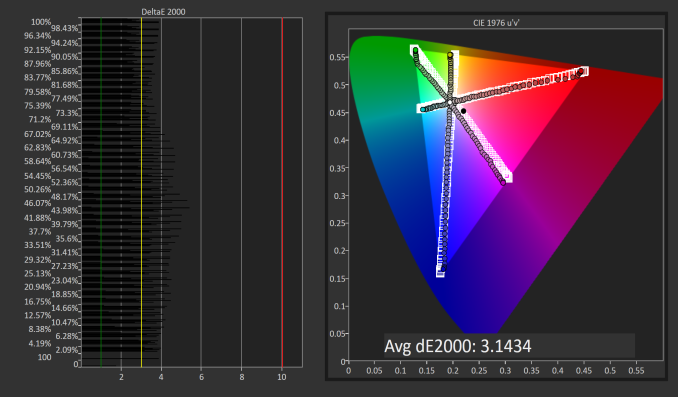
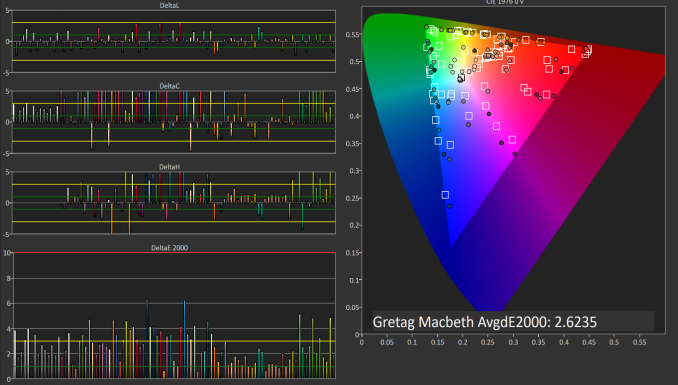








124 Comments
View All Comments
skavi - Thursday, June 15, 2017 - link
They have a coating on the fabric to prevent the worst of wear. If you've touched it, it feels a bit more rubbery than expected based on appearance.BrokenCrayons - Thursday, June 15, 2017 - link
Since the keyboards are easily detached and can be replaced independently of the rest of the tablet, wear and tear might not be a problem as long as you can get your hands on a new one after it starts looking ragged. I know that's not an ideal solution, but it shouldn't discourage purchase of one of these things for those people that still have an interest in buying a tablet in modern times.BillBear - Thursday, June 15, 2017 - link
For $130 apiece, you think they are disposable?fanofanand - Thursday, June 15, 2017 - link
It is an odd position for BrokenCrayons to make, as he is typically a proponent of less waste and spending less on tech. To each their own but this seems to be very inconsistent with his previous posts. I think $2600 is absurd for what you get.BrokenCrayons - Friday, June 16, 2017 - link
My justification is based on the purchase price of the Surface Pro. The price is fairly high relative to the hardware specs and suffers from limits in utility due to its tablet form factor. For someone making that sort of purchase for personal use, I'll go out on a limb to argue that there are emotional and social implications (ex: desire for a status symbol, brand loyalty to Microsoft, etc.) that override practical considerations and therefore the cost of a replacement keyboard is probably a less significant factor than the need to have one that looks fresh and new. In short, this is about the psychology of the buyer which doesn't have a lot to do with my personal preference to use borderline derelict laptops for my own computing needs.Eliadbu - Friday, June 16, 2017 - link
Just buy Eve-V why pay excessive amount of money for a brand.simard57 - Wednesday, June 21, 2017 - link
has the Eve-V been reviewed here at AT?simard57 - Wednesday, June 21, 2017 - link
if HP, Dell or Lenovo offered a 3:2 display - I would seriously consider it.I would lean towards the 360 models. I wonder why Microsoft didn't make the Surface Laptop a 360 model 2-1. are there serious compromises required to support a 360 hinge over a traditional clam shell laptop?
desolation0 - Thursday, June 15, 2017 - link
The $130 version does not include the Alcantara fabric, but also seems to stick with basic black for color scheme. It is not available yet, but is listed on the Microsoft Store. The Alcantara sheathed signature edition cost $160. If you are more worried about durability and a bit of savings than feel and style the regular edition would be your cover of choice. On the subject of durability and replaceability, it should be noted that the keyboard parts for most ultrabooks and laptops are available significantly cheaper. Unfortunately, for many ultrabooks and some laptops the replacement process can be prohibitively difficult for the average consumer. Professional repair service can run you as much or more if you don't shop around successfully.name99 - Thursday, June 15, 2017 - link
Why the insistence on these sorts of very thin "cover" keyboards? Seems like painting yourself into a corner.For iPad you can use a separate bluetooth keyboard (eg the same Apple wireless keyboard that you can use with an iMac) and just carry that with you, along with a very lightweight cover that also acts as a stand (like the Apple cover and a thousand other covers). I assume Surface can also use a BT keyboard.
This pair doesn't look like a laptop anymore, if anything it's more like using an iMac. But it does mean you don't have to force all the compromises and constant weight of a super thin keyboard. It also means that (depending on your exact usage patterns) you can leave the keyboard at home, or in your hotel room, or whatever, and use the on-screen keyboard for small messages, just switching to the real keyboard when you need to type a lot.
Seems to me a better alternative for most users --- but most people seem unaware of it. Even in the Apple store, they were clueless when I explained this to them --- I had to actually demo pairing an Apple keyboard with an iPad before they believed me!
People are just locked into this mental image of "make it look+feel like a laptop" even though that's not necessary.